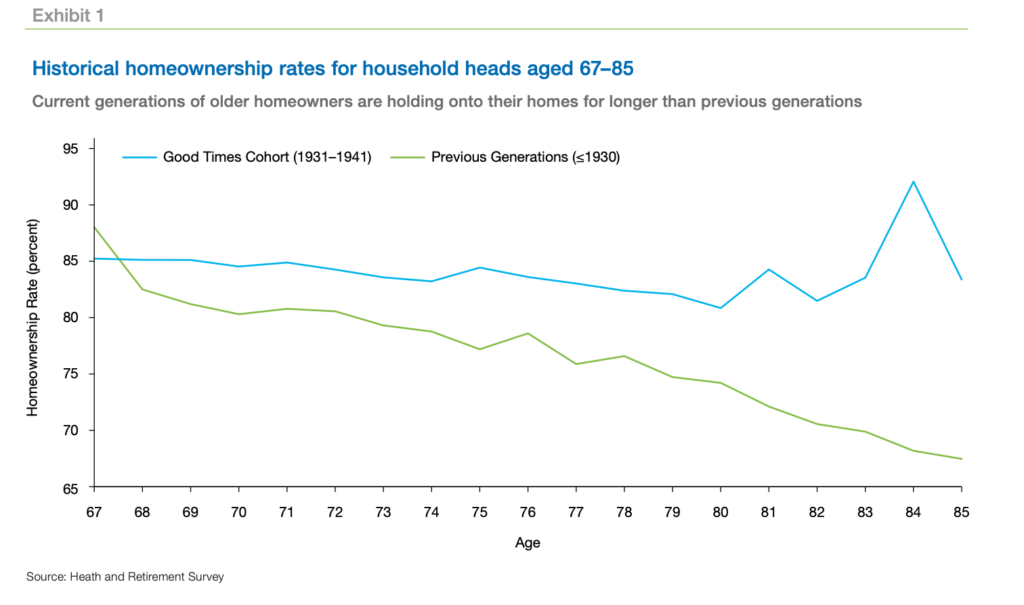At-home care providers are often lauded for their ability to prevent re-hospitalizations and drive down health care costs by allowing older adults to safely age in their existing homes and communities.
As it turns out, their services are having a much broader impact on the U.S. economy, especially when it comes to the real estate market and keeping Americans productive as they grow old.
By now, the idea that most aging adults prefer to age in place is well-known. Roughly 76% of adults over 50 favor remaining in their current home, with 70% desiring to live in their present community for as long as they can, according to AARP statistics.
Nationally, that push has caused a shortage of available housing options for younger generations.
“If you look back several decades ago, when it came to options for older adults, it was either stay at home or move into a nursing home, but now there are so many other options,” Lakelyn Hogan, gerontologist and caregiver advocate at Home Instead Senior Care, told Home Health Care News. “Despite all of those options, so many people want to age where they are comfortable — which most of the time is at home.”
Home Instead Senior Care is an Omaha, Nebraska-based provider of in-home care services with over 1,000 independently owned and operated franchise offices worldwide.
While aging in place often means remaining in one’s own home, experts say that the definition of the term is expanding. Today, the concept also includes things like choosing to move into the home of adult children, downsizing to a smaller home or condo, and making in-home accommodations.
In other words, aging in place means older adults having agency and feeling empowered to choose how and where they age, according to Hogan.
“Staying in the home really allows them to keep their sense of identity,” Hogan said. “And the home is often associated with a sense of independence.”
A housing shortage
While in-home care providers like Home Instead Senior Care have made it easier for older adults to stay in their homes as they get older, aging in place is having far-reaching implications in the real estate market.
Overall, fewer adults between the ages of 67 and 85 are leaving their homes, according to recent research from Freddie Mac. In turn, that’s causing a shortage of available houses for sale on the market.
Freddie Mac is a McLean, Virginia-based government-owned corporation that provides mortgage capital to lenders.
For adults born between 1931 and 1941, homeownership rates only dropped by 3.6% when they turned 67. In comparison, for adults that were born before 1930, homeownership rates dropped 11.6% — which helped keep the stock of available housing in the U.S. relatively high.
In total, aging in place has accounted for about 1.6 million houses held back from the market through 2018, Freddie Mac researchers estimate. That figure is about equal to one year’s typical supply of new construction.

While aging in place has affected the U.S. real estate market on a macro-level, it has had a more localized impact on some places as well, Doug McManus, director of financial research in the office of the chief economist at Freddie Mac, told HHCN.
“If you are in Des Moines, Iowa, it’s very easy to build new structures, so the fact that people want to stay in place is likely to simply lead to more home construction,” McManus said. “In markets like San Francisco, Boston, New York and Wahington, D.C., where it’s relatively difficult to build more units — and homes are a scarce commodity — seniors remaining in their homes really does impact the number of available homes.”
Partly because of aging in place, it’s estimated that 3.4 million millennials are missing out on homeownership, according to recent research from the Urban Institute.
Broadly, the amount of homes retained by seniors is likely to grow in years to come, as both the number of seniors increases and the barriers to staying in place are reduced, the Freddie Mac researchers note.
“When we look at the baby boomer cohort … we expect, as they age, they will be even more likely to stay as homeowners,” McManus said.
Retirees remain productive
Besides impacting the real estate market by limiting available homes, aging in place has also helped older adults stay productive in the economy for longer.
To help meet the demand for their services and overcome industry-wide turnover rates, many home care agencies looking for workers are hiring retirees as caregivers. Home care providers like Cincinnati-based franchise company FirstLight Home Care have been leading the charge.
FirstLight provides about 100,000 hours per week of companion, personal and dementia care services to nearly 4,800 clients across more than 254 locations in 34 states.
First Light — which employs nearly 4,700 caregivers — has been recruiting recent retirees since 2014.
It was a few of FirstLight’s franchise owners seeing success with hiring several retirees that were 65 and older that sparked the original idea to intentionally recruit retirees as a system-wide initiative, CEO Jeff Bevis told HHCN.
“What we have seen first hand is that there is something about seniors caring for other seniors,” Bevis said. “They are often more compassionate and more patient, maybe because, in some cases, they are near the same age. We find that retirees are also a little less stressed — there seems to be a different approach and perspective from a service standpoint with them.”
About 18% to 20% of FirstLight’s workforce is currently over 65.
Other major in-home care providers — including Louisville, Kentucky-based BrightSpring Health Services, formerly known as ResCare — have likewise responded positively to the idea of recruiting this previously untapped worker demographic.
Nearly 40% of adults over the age of 55 were working or actively looking for work in 2014, according to the Bureau of Labor Statistics.
“It’s really just a function of going to where seniors are,” Bevis said. “We go to county senior centers, local senior centers, or even as basic as recruiting at McDonald’s where they offer senior discounts on coffee. We go to those types of establishments and talk to them about part-time work.”
Companies featured in this article:
BrightSpring Health Services, FirstLight Home Care, Freddie Mac, Home Instead Senior Care




